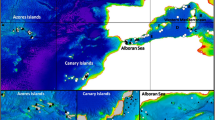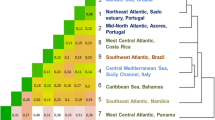Abstract
To improve our understanding of the complex genetic and ecological structure of bottlenose dolphin (Tursiops truncatus) populations, we examined the acoustic features of communication signals from two geographically contiguous areas: the Central–Eastern North Atlantic and the Mediterranean Sea. Variations in the whistles were evaluated for four locations. Ten signal parameters were measured and used to statistically differentiate between the areas. Over 79 % of sightings were correctly classified by discriminant function analysis, confirming an acoustic differentiation between the two basins. The results of cluster analysis using the mean values of the parameters for each sighting showed that the three easternmost sightings from the Mediterranean and one sighting from the Canary archipelago formed a separate cluster from the rest of the Atlantic. The two sightings from the Alboran Sea in the west Mediterranean were grouped with the Atlantic recordings. There was more variability in whistles from the Atlantic Ocean consistent with data from genetic and photo-identification studies that document resident and non-resident animals in the area. The results suggest that the Alboran area may be inhabited by animals differentiated from the rest of the Mediterranean basin as a result of habitat features.




Similar content being viewed by others
References
Azzolin M (2008) Acoustic identification of Mediterranean odontocetes as a prerequisite for their passive acoustic monitoring. Ph.D. Thesis, University of Torino, Italy
Baron SC, Marinez L, Garrison P, Keith KO (2008) Differences in acoustic signals from delphinids in the western North Atlantic and northern Gulf of Mexico. Mar Mamm Sci 24:42–56
Bazua-Duran C, Au WWL (2002) The whistles of Hawaiian spinner dolphins. J Acoust Soc Am 112:3064–3072
Bearzi G, Holcer D, di Notarbartolo Sciara G (2004) The role of historical dolphin takes and habitat degradation in shaping the present status of northern Adriatic cetaceans. Aquat Conserv Mar Freshw Ecosys 14:363–379
Ben Naceur L, Gannier A, Bradai MN, Drouot V, Bourreau S, Laran S, Khalfallah N, Mrabet R, Bdioui M (2004) Recensement du grand dauphin Tursiops truncatus dans les eaux tunisiennes. Bulletin de l'Institute National des Sciences et Technologies de la Mer de Salammbô 31:75–81
Caldwell MC, Caldwell DK (1972) Vocal mimicry in the whistle mode by an Atlantic bottlenosed dolphin. Cetology 9:1–8
Caldwell MC, Caldwell DK, Tyack PL (1990) Review of the signature-whistle hypothesis for the Atlantic bottlenose dolphin. In: Leatherwood S, Reeves RR (eds) The bottlenose dolphin. Academic, San Diego, pp 199–235
Castellote M, Clark CW, Lammers MO (2012) Fin whale (Balaenoptera physalus) population identity in the western Mediterranean Sea. Mar Mamm Sci 28:325–344
Castrillón J, Reyes M, Ruiz L, Pérez-Gil E, Brederlau B, Neves S, Pérez-Gil M, Tejedor M, Servidio A, Herrero R, Lucas T, Urquiola E, Martín V (2011) Simultaneous survey of bottlenose dolphin (Tursiops truncatus) in five special areas of conservation in Canary Islands. 25th Conference of the European Cetacean Society, Cadiz, Spain
Charlton-Robb K, Taylor AC, McKechnie SW (2006) A note on divergent mtDNA lineages of bottlenose dolphins from coastal waters of Southern Australia. J Cet Res Manag 8:173–179
Charlton-Robb K, Gershwin LA, Thompson R, Austin J, Owen K, McKechnie SW (2011) A New Dolphin Species, the Burrunan Dolphin Tursiops australis sp. nov., Endemic to Southern Australian Coastal Waters. PLoS One 6:E24047
Chico C, Jimenez-Torres C, Perez S, Verborgh P, Gauffier P, Esteban R, Gimenez J, Santos ME, De Stephanis R (2011) Survival rate, abundance and residency of bottlenose dolphin (Tursiops truncatus) in the strait of Gibraltar. 25th Conference of the European Cetacean Society, Cadiz, Spain
Duffield DA, Ridgeway SH, Cornell LH (1983) Hematology distinguishes coastal and offshore forms of dolphins (Tursiops). Can J Zool 61:930–933
Forcada J, Gazo M, Aguilar A, Gonzalvo J, Fernandez-Contreras M (2004) Bottlenose dolphin abundance in the NW Mediterranean: addressing heterogeneity in distribution. Mar Ecol Prog Ser 275:275–287
Fripp D, Owen C, Quintana-Rizzo E, Shapiro A, Buckstaff K, Jankowski K, Wells R, Tyack PL (2005) Bottlenose dolphin (Tursiops truncatus) calves appear to model their signature whistles on the signature whistles of community members. Anim Cogn 8:17–26
Gannier A (2005) Summer distribution and relative abundance of delphinids in the Mediterranean sea. Rev Ecol (Terre Vie) 60:223–238
Hawkins ER (2010) Geographic variations in the whistles of bottlenose dolphins (Tursiops aduncus) along the east and west coasts of Australia. J Acoust Soc Am 128:924–935
Hershkovitz P (1966) A catalogue of living whales. Bull US Nat Mus 246:1–259
Hoelzel AR, Potter CW, Best PB (1998) Genetic differentiation between parapatric ‘nearshore’ and ‘offshore’ populations of the bottlenose dolphin. Proc R Soc London B 265:1177–1183
Janik VM (2000) Whistle matching in wild bottlenose dolphin (Tursiops truncatus). Science 289:1355–1357
Janik VM, Slater PJB (1998) Context-specific use suggests that bottlenose dolphin signature whistles are cohesion calls. Anim Behav 56:829–838
Janik VM, Dehnhardt G, Todt D (1994) Signature whistle variations in a bottlenosed dolphin, Tursiops truncatus. Behav Ecol Sociobiol 35:243–248
Jones GJ, Sayigh LS (2002) Geographical variation in rates of vocal production of free-ranging bottlenose dolphins. Mar Mamm Sci 18:374–393
Lachenbruch PA, Mickey MR (1968) Estimation of error rates in discriminant analysis. Technometrics 10:1–11
Lehner PN (1998) Handbook of ethological methods, 2nd edn. Cambridge University, Cambridge, p 672
Louis M, Guinet C, Lucas T, Viricel A, Peltier H, Alfonsi E, Berrow S, Brownlow A, Covelo P, Dabin W, Deaville R, Gally F, Gauffier P, Penrose R, Silva M, Simon-Bouhet B (2013) Population genetics of bottlenose dolphins in the North East Atlantic: a pelagic versus coastal segregation. 27th Conference of the European Cetacean Society, Setubal, Portugal
May-Collado LJ, Wartzok D (2008) A comparison of bottlenose dolphin whistles in the Atlantic Ocean: factors promoting whistle variation. J Mammal 89:1229–1240
May-Collado LJ, Agnarsson I, Wartzok D (2007) Re-examining the relationship between body size and tonal signals frequency in whales: a comparative approach using a novel phylogeny. Mar Mamm Sci 23:524–552
Mead JG, Potter CW (1995) Recognizing two populations of the bottlenose dolphin (Tursiops truncatus) of the Atlantic coast of North America: morphologic and ecologic considerations. IBI Rep 5:31–44
Morato T, Machete M, Kitchingman A, Tempera F, Lai S, Menezes G, Pitcher TJ, Santos RS (2008) Abundance and distribution of seamounts in the Azores. Mar Ecol Prog Ser 357:17–21
Morisaka T, Shinohara M, Nakahara F, Akamatsu T (2005) Geographic variations in the whistles among three Indo-Pacific bottlenose dolphin Tursiops aduncus populations in Japan. Fish Sci 71:568–576
Natoli A, Peddemors VM, Hoelzel AR (2004) Population structure and speciation in the genus Tursiops based on microsatellite and mitochondrial DNA analyses. J Evol Biol 17:363–375
Natoli A, Birkun A, Aguilar A, Lopez A, Hoelzel AR (2005) Habitat structure and the dispersal of male and female bottlenose dolphins (Tursiops truncatus) based on microsatellite and mitochondrial DNA analyses. Proc R Soc London B 272:1217–1226
Notarbartolo di Sciara G, Demma M (2004) Guida dei mammiferi marini del Mediterraneo. In: Franco Muzzio (Ed) Scienze naturali Padova
Oswald JN, Barlow J, Norris TF (2003) Acoustic identification of nine delphinid species in the eastern tropical pacific ocean. Mar Mamm Sci 19:20–37
Oswald JN, Rankin S, Barlow J, Lammers MO (2007) A tool for real-time acoustic species identification of delphinid whistles. J Acoust Soc Am 122:587–595
Papale E, Azzolin M, Cascão I, Gannier A, Lammers MO, Martin VM, Oswald J, Perez-Gil M, Prieto R, Silva MA, Giacoma C (2013) Geographic variability in the acoustic parameters of striped dolphin’s (Stenella coeruleoalba) whistles. J Acous Soc Am 133(2):1126–1134
Quérouil S, Silva MA, Freitas L, Prieto R, Magalhaes S, Dinis A, Alves F, Matos JA, Mendonca D, Hammond PS, Santos RS (2007) High gene flow in oceanic bottlenose dolphins (Tursiops truncatus) of the North Atlantic. Conserv Genet. doi:10.1007/s10592-007-9291-5
Reiss D, McCowan B (1993) Spontaneous vocal mimicry and production by bottlenose dolphins (Tursiops truncatus): evidence for vocal learning. J Comp Psychol 107:301–312
Ross GJB (1977) The taxonomy of bottlenose dolphins, Tursiops species, in South African waters, with notes on their biology. Ann Cape Provincial Mus 11:135–194
Ross GJB (1984) The smaller cetaceans of the southeast coast of southern Africa. Ann Cape Provincial Mus 15:173–410
Ross GJB, Cockcroft VC (1990) Comments on Australian bottlenose dolphins and the taxonomic status of Tursiops aduncus (Ehrenberg, 1832). In: Leatherwood S, Reeves RR (eds) The bottlenose dolphin. Academic, New York, pp 101–128
Sayigh LS, Tyack PT, Wells RS, Scott MD (1990) Signature whistles of free-ranging bottlenose dolphins Tursiops truncatus: stability and mother–offspring comparisons. Behav Ecol Sociobiol 26:247–260
Sayigh LS, Tyack PL, Wells RS, Solows AR, Scott MD, Irvine AB (1998) Individual recognition in wild bottlenose dolphins: a field test using playback experiments. Anim Behav 57:41–50
Segura I, Rocha-Olivares A, Flores-Ramırez S, Rojas-Bracho L (2006) Conservation implications of the genetic and ecological distinction of Tursiops truncatus ecotypes in the Gulf of California. Biol Conserv 133:336–346
Silva MA, Prieto R, Magalhães S, Seabra MI, Santos RS, Hammond PS (2008) Ranging patterns of bottlenose dolphins living in oceanic waters: implications for population structure. Mar Biol 156:179–192
Tobeña M, Escanez A, Rodriguez Y, Lopez C, Aguilar N (2011) Inter-island movement of bottlenose dolphins (Tursiops truncatus) in the Canary islands: implications for conservation and SAC design. 25th Conference of the European Cetacean Society Cadiz, Spain
Torres LG, Rosel PE, D'Agrosa C, Read AJ (2003) Improving management of overlapping bottlenose dolphin ecotypes through spatial analysis and genetics. Mar Mamm Sci 19:502–514
Tyack PL (1986) Whistle repertoires of two bottlenosed dolphins, Tursiops truncatus: mimicry of signature whistles? Behav Ecol Sociobiol 18:251–257
Tyack PL (1997) Development and social functions of signature whistles in bottlenose dolphins Tursiops truncatus. Bioacoustics 8:21–46
Van Waerebeek K, Reyes JC, Read AJ, McKinnon J (1990) Preliminary observations of bottlenose dolphins from the Pacific coast of South America. In: Leatherwood S, Reeves RR (eds) The bottlenose dolphin. Academic, New York, pp 143–154
Viaud-Martinez KA, Brownell RL, Komnenou A, Bohonak AJ (2008) Genetic isolation and morphological divergence of Black Sea bottlenose dolphins. Biol Conserv 141:1600–1611
Walker WA (1981) Geographic variation in morphology and biology of bottlenose dolphins (Tursiops) in the eastern North Pacific. NOAA/NMFS Southwest Fisheries Science Centre Administrative Report no. LJ-81-3c
Wang D, Wursig B, Evans WE (1995) Whistles of bottlenose dolphins: comparisons among populations. Aquat Mamm 21:65–67
Wells RS, Rhinehart HL, Cunningham P, Whaley J, Baran M, Koberna C, Costa DP (1999) Long distance offshore movements of bottlenose dolphins. Mar Mamm Sci 15:1098–1114
Acknowledgments
The authors are grateful to IFAW for its contribution in the data collection. Without its support, this project could not have been accomplished. Data collection and processing in the Azores was funded by Fundação para a Ciência e a Tecnologia (FCT), Direcção Regional Para a Ciência, Tecnologia e Comunicações (DRCTC), FEDER, the Competitiveness Factors Operational (COMPETE), QREN European Social Fund and Proconvergência Açores Program through research projects PTDC/MAR/74071/2006 and M2.1.2/F/012/2011. The authors acknowledge funds provided by FCT to LARSyS Associated Laboratory and IMAR-University of the Azores/the Thematic Area E of the Strategic Project (OE and compete) and by the DRCTC–Government of the Azores pluriannual funding. MAS was supported by an FCT postdoctoral grant (SFRH/BPD/29841/2006), IC and RP were supported by FCT doctoral grants (respectively SFRH/BD/41192/2007 and SFRH/BD/32520/2006). RP received a research grant from the Azores Regional Fund for Science and Technology (M3.1.5/F/115/2012). Data collection by SECAC was funded by the EU LIFE programme—project LIFE INDEMARES (LIFE 07/NAT/E/000732)—and the Fundación Biodiversidad under the Spanish Ministry of Environment, Rural and Marine Affairs (project ZEC-TURSIOPS).
Conflict of interest
None of the authors has any conflict of interest with the contents of the manuscript.
Ethical standards
The work has been carried out without putting at risk endangered populations, species or habitats in agreements with the “Guidelines for the Use of Animals in Research.”
Author information
Authors and Affiliations
Corresponding author
Rights and permissions
About this article
Cite this article
Papale, E., Azzolin, M., Cascão, I. et al. Acoustic divergence between bottlenose dolphin whistles from the Central–Eastern North Atlantic and Mediterranean Sea. acta ethol 17, 155–165 (2014). https://doi.org/10.1007/s10211-013-0172-2
Received:
Revised:
Accepted:
Published:
Issue Date:
DOI: https://doi.org/10.1007/s10211-013-0172-2




